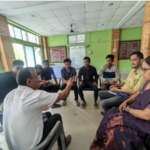Vishal Upadhaya
We say that the youths of today are the pillars of the future…..but where do the youths come from……Well I suppose they start as infants, than children and gradually become youths.
If the government and the voluntary agencies devoted half as much of time to devise a viable strategy to eliminate child labor as they do to meaningless displays of public concern, the problem would have been erased a long time back. An example of this was a spectacle in the capital of a human chain of child workers organized by the Campaign Against Child Labour in which more than 700 N.G.O’s took part. The exercise served no purpose than to traumatize the bare-footed children who were forced to walk on a hot day down a busy thoroughfare, with high speed traffic thundering past inches away from them. The much-touted meet produced that “something” must be done. But we have known that for at least the last 84 years, haven’t we?
In the March 1931 Lahore session of the Congress, Mahatma Gandhi presided over 20 resolutions to protect the rights of children. Today, unofficial figures of child labor in INDIA stand at 55 million (25 million children employed in agricultural lands, 20 million in service sectors (hotels, shops and as servants in home) and 5 million in the handloom, carpet making, gem cutting and match making industries. 91 per cent of child labor in India is in rural areas, while 9 per cent is in urban areas. In India every third child is a working child and every fourth child in the age group of 5 to 15 is Child (ILO, 2007). Thus a considerable number of children are not only losing their childhood but also quality time for proper education. However, whatever estimate we take, this inevitable reality remains the same that child labour is a problem of massive proportion.
Many of them succumb to the harsh environment they function in and those who survive are physically and mentally shattered. The government’s response has always been to frame more legislation earning India the dubious distinction of having the maximum number of laws to combat this evil. Periodically target dates are set by which the problem will cease to exist —– (In the year 1997 the government had committed to wipe out child labour by 2000). And now, even after 14 years these hollow promises stand exposed nothing at all has changed on the ground.
It is nobody’s contention that the government or indeed voluntary agencies can wave a magic wand and do away with child labor overnight. Poverty, illiteracy and unemployment have created conditions in which eliminating child labor has become an increasingly daunting task. But that can be excuse for the present poverty of ideas and tardy implementation of laws. The government’s half-hearted attempt earlier to withdraw concessions to industries employing child labour did not yield any results. Then came the Rs.850 crore scheme to liberate and rehabilitate two million child workers a year over a period of five years. This is far from adequate given the number of children in bondage all over the country. Predictably we hear nothing about what happened to the money or how many children the allotted funds helped to liberate. Now all attention is on plugging loopholes in the Child Labour (Prohibition and Regulation)Act 1986 which can only mean yet more legislation. All these strategies, even if implemented effectively, will not address the root problem.
Half the battle will be won when free and compulsory education becomes available to all children upto the age of 14. In states like Kerala where the ‘education for all’ mantra has been made a reality, child labour is unheard of. Yet in India, the government is far more committed to the universalization of education for the age group 11-14. It must realize that the only to contain child labour is to ensure that children do not enter the job-market in the first place. If this is not done, today’s illiterate child workers will become tomorrows’ illiterate and unskilled adults.
To factually support how deep rooted it is, NGOs working towards eradicating child labor in India have put some startling figures that can put our head to shame. Two out of every three working children are physically abused; 50.2 percent children worked seven days a week; 53.22 percent children reported having faced one or more forms of sexual abuse and lastly, every second child reported facing emotional abuse. Instead of waiting for “acchey din” we each and every one of us really need to do something about it. Let us all unite to see these children smile for-ever.
The writer can be reached at: vishalupadhaya08@gmail.com







